Arden University: MSc Strategic Engineering Management Dissertation
VerifiedAdded on 2021/04/17
|130
|25398
|152
Thesis and Dissertation
AI Summary
This dissertation, submitted for an MSc in Strategic Engineering Management at Arden University, evaluates the significance of project management soft skills for project success. The research employs a mixed-methods approach, including a survey and case studies, to analyze the impact of soft skills such as communication, leadership, conflict management, and negotiation on project outcomes. The study highlights the importance of soft skills in project management, particularly in developing countries, and identifies factors contributing to project failure and success. Findings from quantitative analysis suggest the need to focus on soft skills to improve project success rates. Qualitative analysis, based on case studies, supports the quantitative findings, providing a comprehensive view of how soft skills influence project management. The dissertation also provides recommendations for future research and acknowledges the limitations of the study. The research concludes that investing in soft skills is crucial for enhancing project success rates.
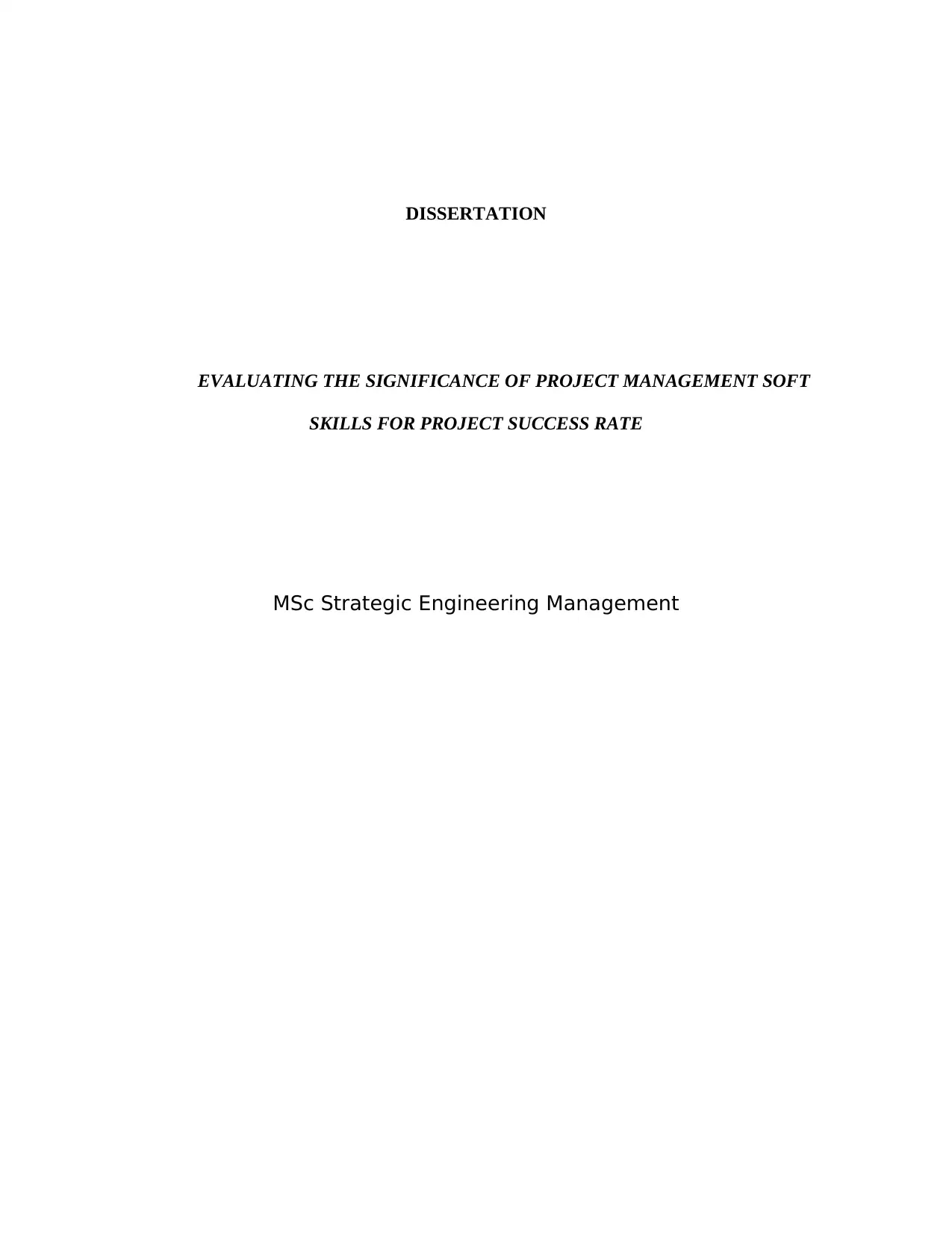
DISSERTATION
EVALUATING THE SIGNIFICANCE OF PROJECT MANAGEMENT SOFT
SKILLS FOR PROJECT SUCCESS RATE
MSc Strategic Engineering Management
EVALUATING THE SIGNIFICANCE OF PROJECT MANAGEMENT SOFT
SKILLS FOR PROJECT SUCCESS RATE
MSc Strategic Engineering Management
Paraphrase This Document
Need a fresh take? Get an instant paraphrase of this document with our AI Paraphraser
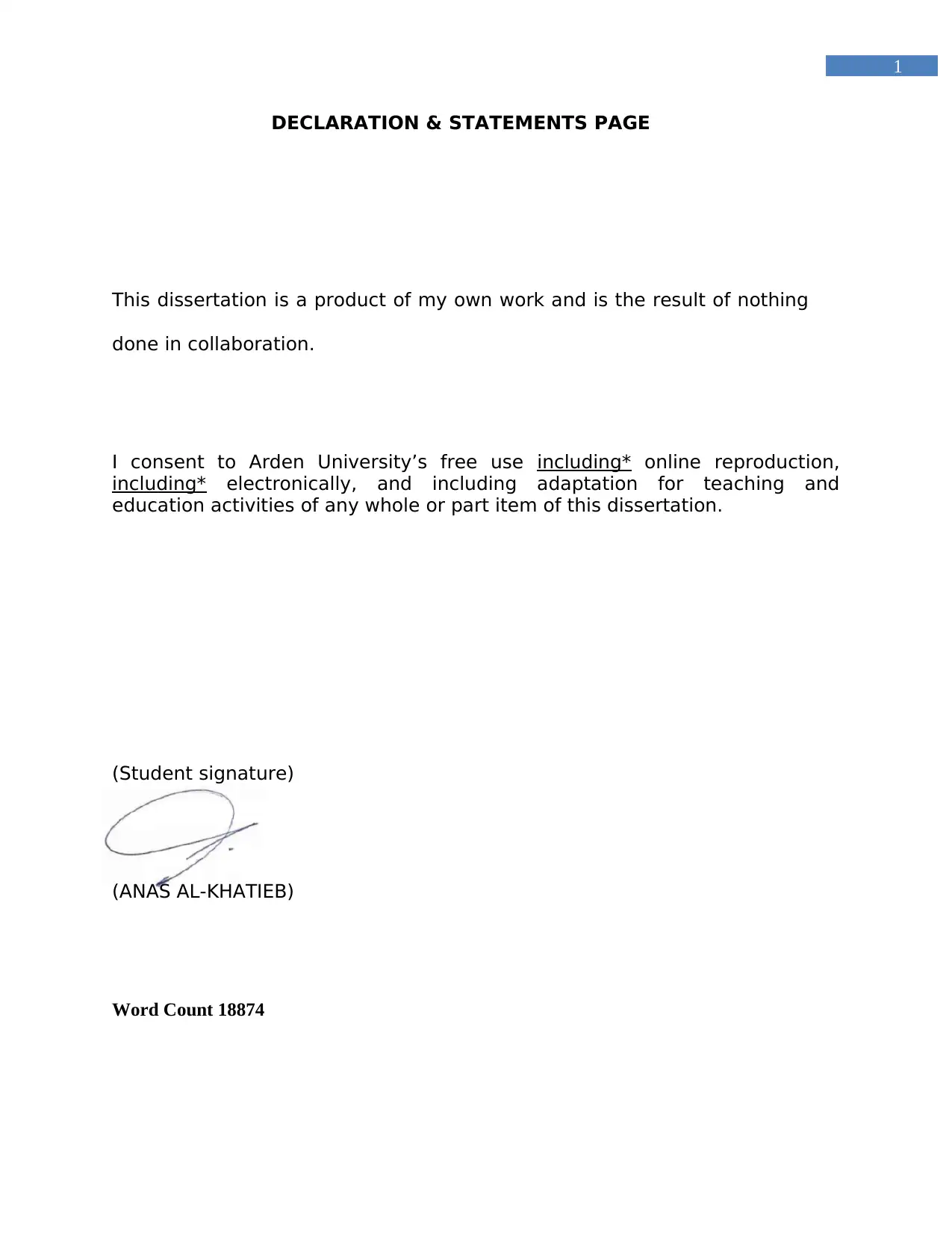
1
DECLARATION & STATEMENTS PAGE
This dissertation is a product of my own work and is the result of nothing
done in collaboration.
I consent to Arden University’s free use including* online reproduction,
including* electronically, and including adaptation for teaching and
education activities of any whole or part item of this dissertation.
(Student signature)
(ANAS AL-KHATIEB)
Word Count 18874
DECLARATION & STATEMENTS PAGE
This dissertation is a product of my own work and is the result of nothing
done in collaboration.
I consent to Arden University’s free use including* online reproduction,
including* electronically, and including adaptation for teaching and
education activities of any whole or part item of this dissertation.
(Student signature)
(ANAS AL-KHATIEB)
Word Count 18874
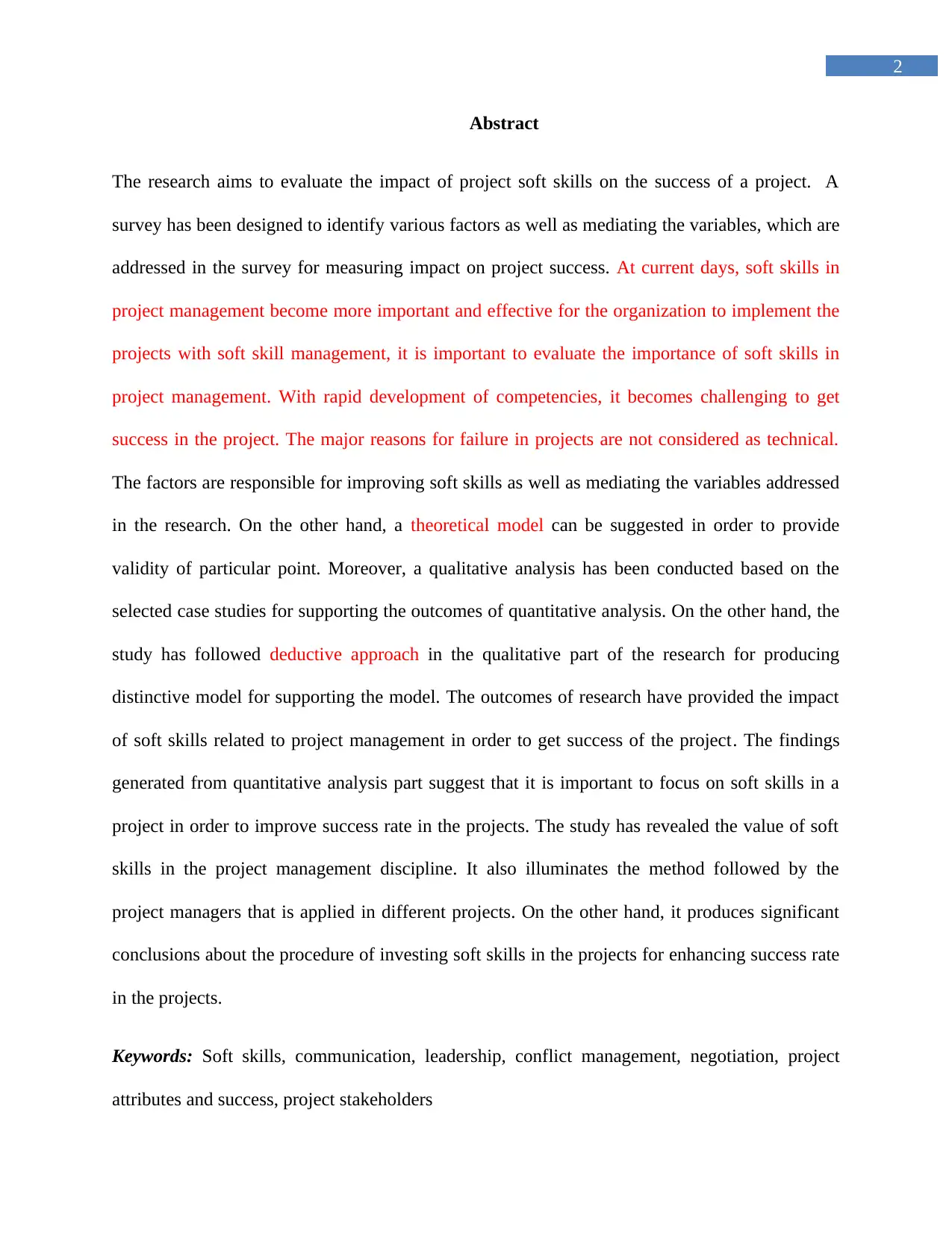
2
Abstract
The research aims to evaluate the impact of project soft skills on the success of a project. A
survey has been designed to identify various factors as well as mediating the variables, which are
addressed in the survey for measuring impact on project success. At current days, soft skills in
project management become more important and effective for the organization to implement the
projects with soft skill management, it is important to evaluate the importance of soft skills in
project management. With rapid development of competencies, it becomes challenging to get
success in the project. The major reasons for failure in projects are not considered as technical.
The factors are responsible for improving soft skills as well as mediating the variables addressed
in the research. On the other hand, a theoretical model can be suggested in order to provide
validity of particular point. Moreover, a qualitative analysis has been conducted based on the
selected case studies for supporting the outcomes of quantitative analysis. On the other hand, the
study has followed deductive approach in the qualitative part of the research for producing
distinctive model for supporting the model. The outcomes of research have provided the impact
of soft skills related to project management in order to get success of the project. The findings
generated from quantitative analysis part suggest that it is important to focus on soft skills in a
project in order to improve success rate in the projects. The study has revealed the value of soft
skills in the project management discipline. It also illuminates the method followed by the
project managers that is applied in different projects. On the other hand, it produces significant
conclusions about the procedure of investing soft skills in the projects for enhancing success rate
in the projects.
Keywords: Soft skills, communication, leadership, conflict management, negotiation, project
attributes and success, project stakeholders
Abstract
The research aims to evaluate the impact of project soft skills on the success of a project. A
survey has been designed to identify various factors as well as mediating the variables, which are
addressed in the survey for measuring impact on project success. At current days, soft skills in
project management become more important and effective for the organization to implement the
projects with soft skill management, it is important to evaluate the importance of soft skills in
project management. With rapid development of competencies, it becomes challenging to get
success in the project. The major reasons for failure in projects are not considered as technical.
The factors are responsible for improving soft skills as well as mediating the variables addressed
in the research. On the other hand, a theoretical model can be suggested in order to provide
validity of particular point. Moreover, a qualitative analysis has been conducted based on the
selected case studies for supporting the outcomes of quantitative analysis. On the other hand, the
study has followed deductive approach in the qualitative part of the research for producing
distinctive model for supporting the model. The outcomes of research have provided the impact
of soft skills related to project management in order to get success of the project. The findings
generated from quantitative analysis part suggest that it is important to focus on soft skills in a
project in order to improve success rate in the projects. The study has revealed the value of soft
skills in the project management discipline. It also illuminates the method followed by the
project managers that is applied in different projects. On the other hand, it produces significant
conclusions about the procedure of investing soft skills in the projects for enhancing success rate
in the projects.
Keywords: Soft skills, communication, leadership, conflict management, negotiation, project
attributes and success, project stakeholders
⊘ This is a preview!⊘
Do you want full access?
Subscribe today to unlock all pages.

Trusted by 1+ million students worldwide
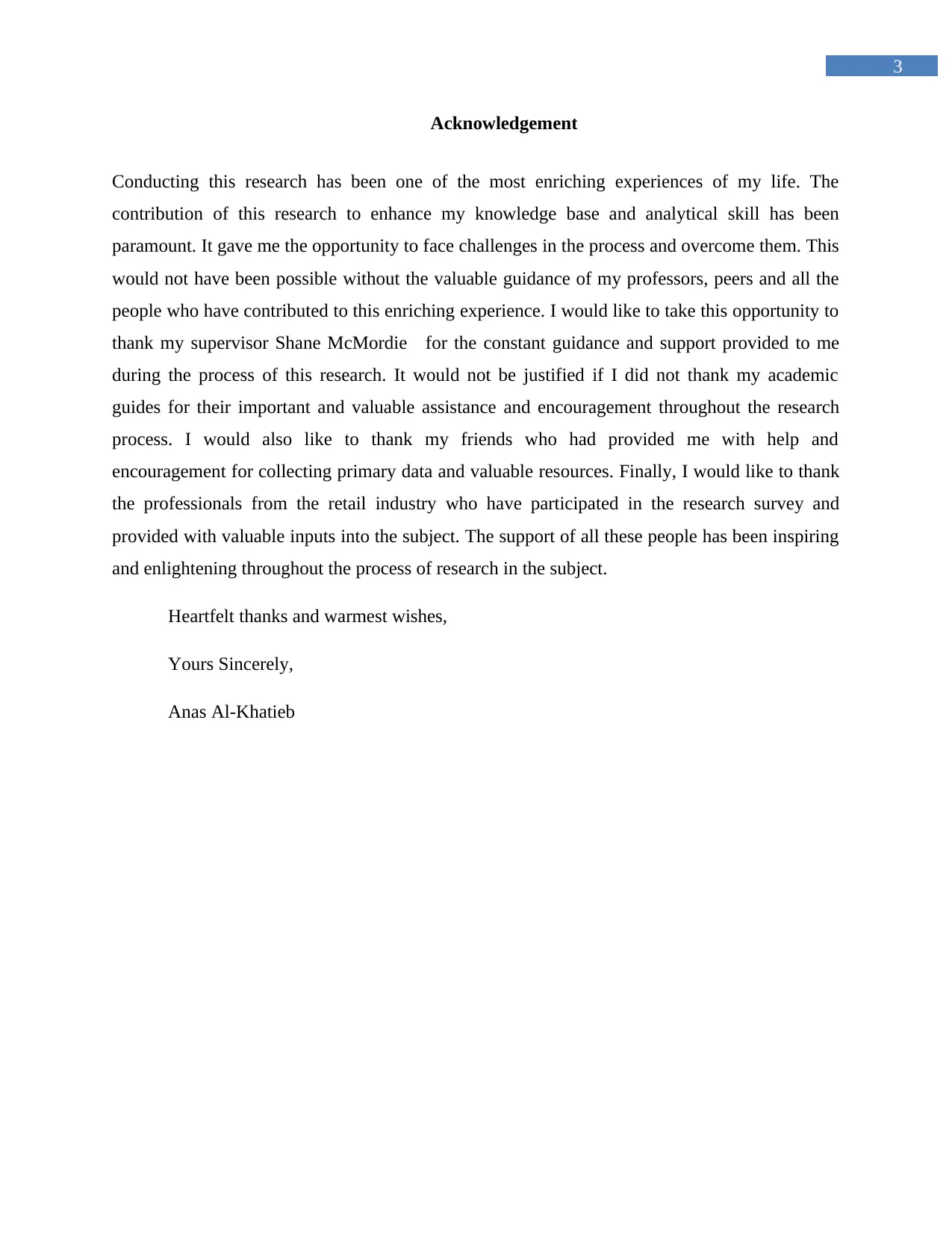
3
Acknowledgement
Conducting this research has been one of the most enriching experiences of my life. The
contribution of this research to enhance my knowledge base and analytical skill has been
paramount. It gave me the opportunity to face challenges in the process and overcome them. This
would not have been possible without the valuable guidance of my professors, peers and all the
people who have contributed to this enriching experience. I would like to take this opportunity to
thank my supervisor Shane McMordie for the constant guidance and support provided to me
during the process of this research. It would not be justified if I did not thank my academic
guides for their important and valuable assistance and encouragement throughout the research
process. I would also like to thank my friends who had provided me with help and
encouragement for collecting primary data and valuable resources. Finally, I would like to thank
the professionals from the retail industry who have participated in the research survey and
provided with valuable inputs into the subject. The support of all these people has been inspiring
and enlightening throughout the process of research in the subject.
Heartfelt thanks and warmest wishes,
Yours Sincerely,
Anas Al-Khatieb
Acknowledgement
Conducting this research has been one of the most enriching experiences of my life. The
contribution of this research to enhance my knowledge base and analytical skill has been
paramount. It gave me the opportunity to face challenges in the process and overcome them. This
would not have been possible without the valuable guidance of my professors, peers and all the
people who have contributed to this enriching experience. I would like to take this opportunity to
thank my supervisor Shane McMordie for the constant guidance and support provided to me
during the process of this research. It would not be justified if I did not thank my academic
guides for their important and valuable assistance and encouragement throughout the research
process. I would also like to thank my friends who had provided me with help and
encouragement for collecting primary data and valuable resources. Finally, I would like to thank
the professionals from the retail industry who have participated in the research survey and
provided with valuable inputs into the subject. The support of all these people has been inspiring
and enlightening throughout the process of research in the subject.
Heartfelt thanks and warmest wishes,
Yours Sincerely,
Anas Al-Khatieb
Paraphrase This Document
Need a fresh take? Get an instant paraphrase of this document with our AI Paraphraser
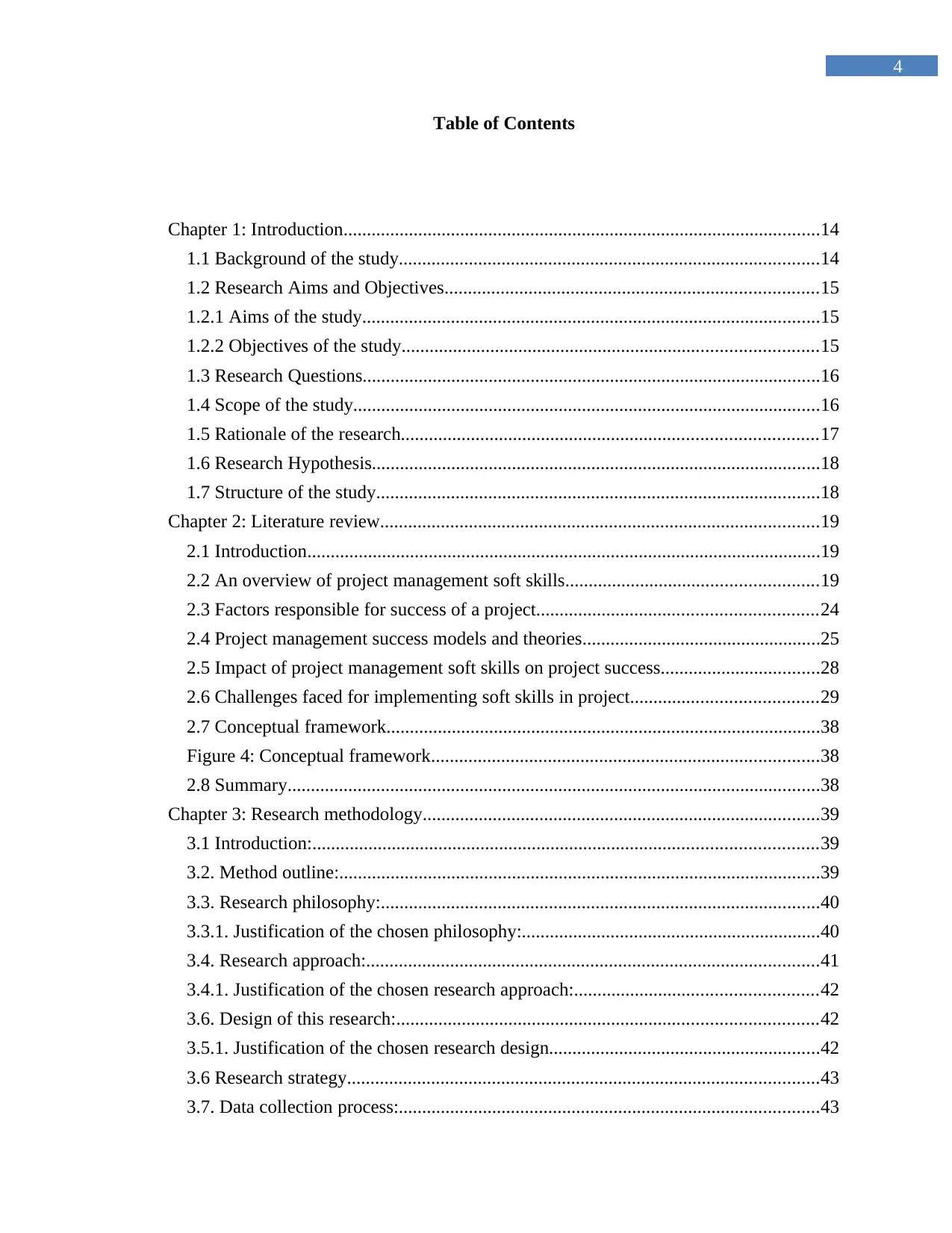
4
Table of Contents
Chapter 1: Introduction......................................................................................................14
1.1 Background of the study..........................................................................................14
1.2 Research Aims and Objectives................................................................................15
1.2.1 Aims of the study..................................................................................................15
1.2.2 Objectives of the study.........................................................................................15
1.3 Research Questions..................................................................................................16
1.4 Scope of the study....................................................................................................16
1.5 Rationale of the research.........................................................................................17
1.6 Research Hypothesis................................................................................................18
1.7 Structure of the study...............................................................................................18
Chapter 2: Literature review..............................................................................................19
2.1 Introduction..............................................................................................................19
2.2 An overview of project management soft skills......................................................19
2.3 Factors responsible for success of a project............................................................24
2.4 Project management success models and theories...................................................25
2.5 Impact of project management soft skills on project success..................................28
2.6 Challenges faced for implementing soft skills in project........................................29
2.7 Conceptual framework.............................................................................................38
Figure 4: Conceptual framework...................................................................................38
2.8 Summary..................................................................................................................38
Chapter 3: Research methodology.....................................................................................39
3.1 Introduction:............................................................................................................39
3.2. Method outline:.......................................................................................................39
3.3. Research philosophy:..............................................................................................40
3.3.1. Justification of the chosen philosophy:................................................................40
3.4. Research approach:.................................................................................................41
3.4.1. Justification of the chosen research approach:....................................................42
3.6. Design of this research:..........................................................................................42
3.5.1. Justification of the chosen research design..........................................................42
3.6 Research strategy.....................................................................................................43
3.7. Data collection process:..........................................................................................43
Table of Contents
Chapter 1: Introduction......................................................................................................14
1.1 Background of the study..........................................................................................14
1.2 Research Aims and Objectives................................................................................15
1.2.1 Aims of the study..................................................................................................15
1.2.2 Objectives of the study.........................................................................................15
1.3 Research Questions..................................................................................................16
1.4 Scope of the study....................................................................................................16
1.5 Rationale of the research.........................................................................................17
1.6 Research Hypothesis................................................................................................18
1.7 Structure of the study...............................................................................................18
Chapter 2: Literature review..............................................................................................19
2.1 Introduction..............................................................................................................19
2.2 An overview of project management soft skills......................................................19
2.3 Factors responsible for success of a project............................................................24
2.4 Project management success models and theories...................................................25
2.5 Impact of project management soft skills on project success..................................28
2.6 Challenges faced for implementing soft skills in project........................................29
2.7 Conceptual framework.............................................................................................38
Figure 4: Conceptual framework...................................................................................38
2.8 Summary..................................................................................................................38
Chapter 3: Research methodology.....................................................................................39
3.1 Introduction:............................................................................................................39
3.2. Method outline:.......................................................................................................39
3.3. Research philosophy:..............................................................................................40
3.3.1. Justification of the chosen philosophy:................................................................40
3.4. Research approach:.................................................................................................41
3.4.1. Justification of the chosen research approach:....................................................42
3.6. Design of this research:..........................................................................................42
3.5.1. Justification of the chosen research design..........................................................42
3.6 Research strategy.....................................................................................................43
3.7. Data collection process:..........................................................................................43
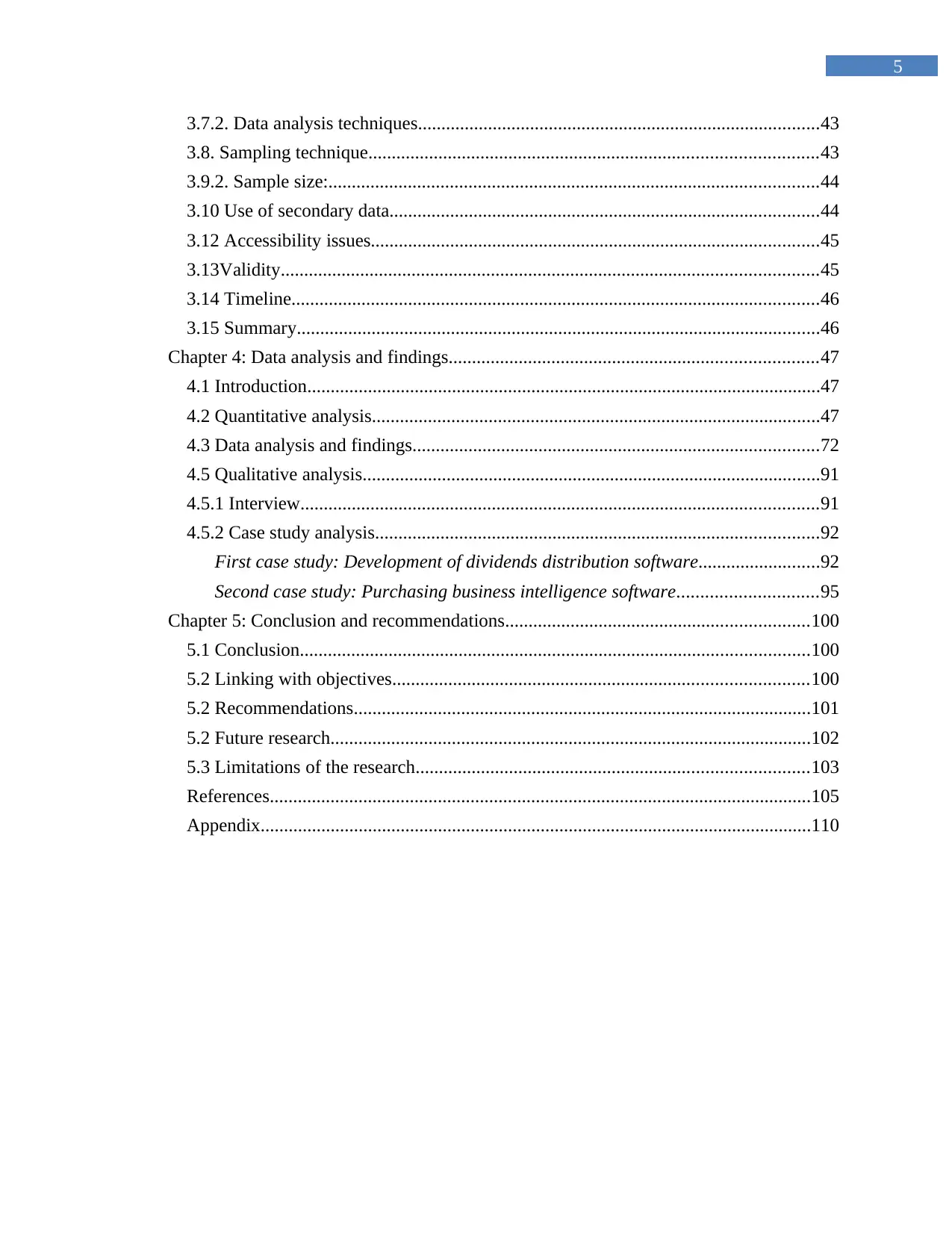
5
3.7.2. Data analysis techniques......................................................................................43
3.8. Sampling technique................................................................................................43
3.9.2. Sample size:.........................................................................................................44
3.10 Use of secondary data............................................................................................44
3.12 Accessibility issues................................................................................................45
3.13Validity...................................................................................................................45
3.14 Timeline.................................................................................................................46
3.15 Summary................................................................................................................46
Chapter 4: Data analysis and findings...............................................................................47
4.1 Introduction..............................................................................................................47
4.2 Quantitative analysis................................................................................................47
4.3 Data analysis and findings.......................................................................................72
4.5 Qualitative analysis..................................................................................................91
4.5.1 Interview...............................................................................................................91
4.5.2 Case study analysis...............................................................................................92
First case study: Development of dividends distribution software..........................92
Second case study: Purchasing business intelligence software..............................95
Chapter 5: Conclusion and recommendations.................................................................100
5.1 Conclusion.............................................................................................................100
5.2 Linking with objectives.........................................................................................100
5.2 Recommendations..................................................................................................101
5.2 Future research.......................................................................................................102
5.3 Limitations of the research....................................................................................103
References....................................................................................................................105
Appendix......................................................................................................................110
3.7.2. Data analysis techniques......................................................................................43
3.8. Sampling technique................................................................................................43
3.9.2. Sample size:.........................................................................................................44
3.10 Use of secondary data............................................................................................44
3.12 Accessibility issues................................................................................................45
3.13Validity...................................................................................................................45
3.14 Timeline.................................................................................................................46
3.15 Summary................................................................................................................46
Chapter 4: Data analysis and findings...............................................................................47
4.1 Introduction..............................................................................................................47
4.2 Quantitative analysis................................................................................................47
4.3 Data analysis and findings.......................................................................................72
4.5 Qualitative analysis..................................................................................................91
4.5.1 Interview...............................................................................................................91
4.5.2 Case study analysis...............................................................................................92
First case study: Development of dividends distribution software..........................92
Second case study: Purchasing business intelligence software..............................95
Chapter 5: Conclusion and recommendations.................................................................100
5.1 Conclusion.............................................................................................................100
5.2 Linking with objectives.........................................................................................100
5.2 Recommendations..................................................................................................101
5.2 Future research.......................................................................................................102
5.3 Limitations of the research....................................................................................103
References....................................................................................................................105
Appendix......................................................................................................................110
⊘ This is a preview!⊘
Do you want full access?
Subscribe today to unlock all pages.

Trusted by 1+ million students worldwide

6
List of tables
Table 1: Gantt chart...........................................................................................................38
Table 2: Regression analysis (1)........................................................................................67
Table 3: Regression analysis (2)........................................................................................69
Table 4: Regression analysis (3)........................................................................................73
Table 4: Regression analysis (3)........................................................................................75
Table 5: Descriptive statistics............................................................................................79
Table 6: Regression analysis (4)........................................................................................81
List of tables
Table 1: Gantt chart...........................................................................................................38
Table 2: Regression analysis (1)........................................................................................67
Table 3: Regression analysis (2)........................................................................................69
Table 4: Regression analysis (3)........................................................................................73
Table 4: Regression analysis (3)........................................................................................75
Table 5: Descriptive statistics............................................................................................79
Table 6: Regression analysis (4)........................................................................................81
Paraphrase This Document
Need a fresh take? Get an instant paraphrase of this document with our AI Paraphraser
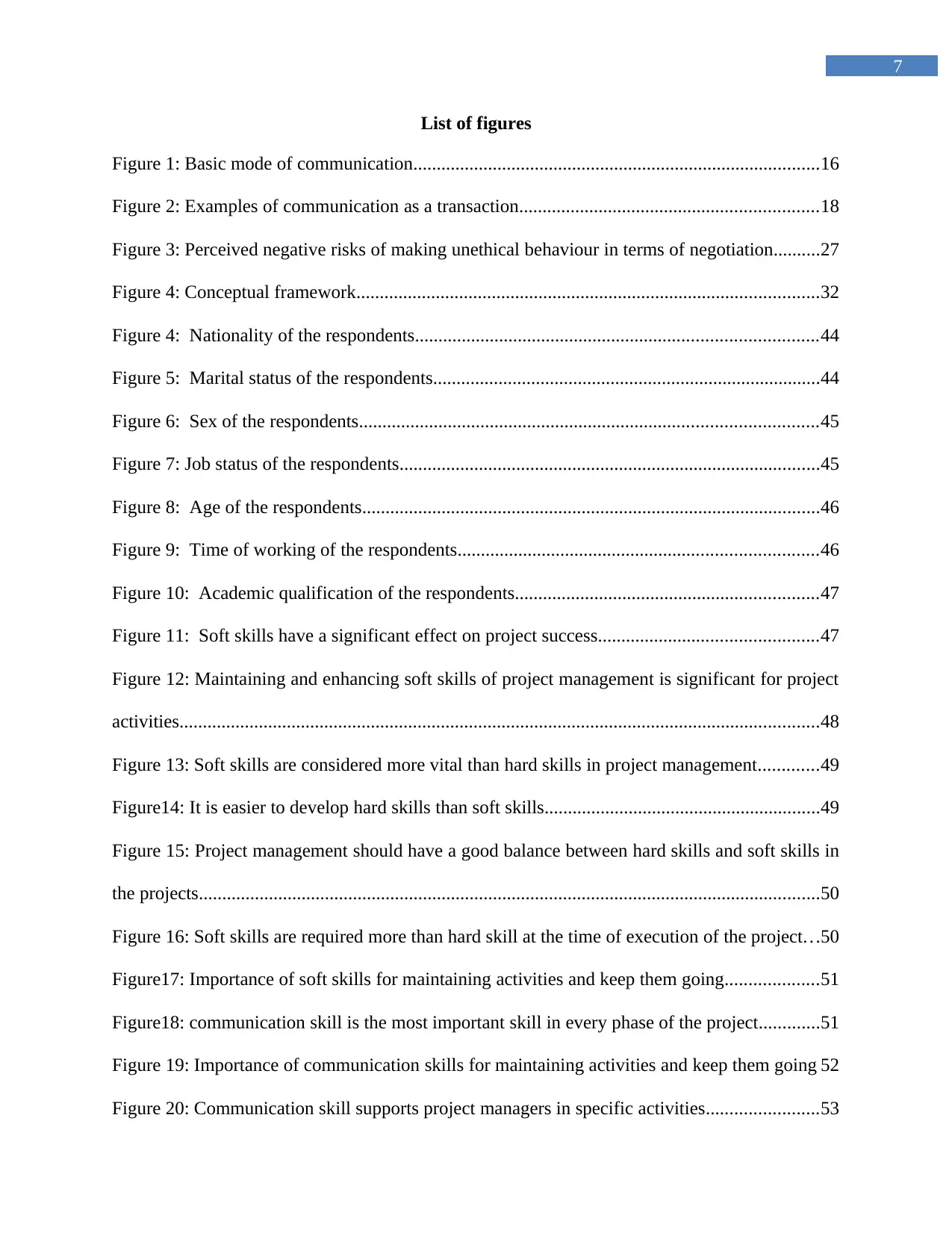
7
List of figures
Figure 1: Basic mode of communication.......................................................................................16
Figure 2: Examples of communication as a transaction................................................................18
Figure 3: Perceived negative risks of making unethical behaviour in terms of negotiation..........27
Figure 4: Conceptual framework...................................................................................................32
Figure 4: Nationality of the respondents......................................................................................44
Figure 5: Marital status of the respondents...................................................................................44
Figure 6: Sex of the respondents..................................................................................................45
Figure 7: Job status of the respondents..........................................................................................45
Figure 8: Age of the respondents..................................................................................................46
Figure 9: Time of working of the respondents.............................................................................46
Figure 10: Academic qualification of the respondents.................................................................47
Figure 11: Soft skills have a significant effect on project success...............................................47
Figure 12: Maintaining and enhancing soft skills of project management is significant for project
activities.........................................................................................................................................48
Figure 13: Soft skills are considered more vital than hard skills in project management.............49
Figure14: It is easier to develop hard skills than soft skills...........................................................49
Figure 15: Project management should have a good balance between hard skills and soft skills in
the projects.....................................................................................................................................50
Figure 16: Soft skills are required more than hard skill at the time of execution of the project...50
Figure17: Importance of soft skills for maintaining activities and keep them going....................51
Figure18: communication skill is the most important skill in every phase of the project.............51
Figure 19: Importance of communication skills for maintaining activities and keep them going 52
Figure 20: Communication skill supports project managers in specific activities........................53
List of figures
Figure 1: Basic mode of communication.......................................................................................16
Figure 2: Examples of communication as a transaction................................................................18
Figure 3: Perceived negative risks of making unethical behaviour in terms of negotiation..........27
Figure 4: Conceptual framework...................................................................................................32
Figure 4: Nationality of the respondents......................................................................................44
Figure 5: Marital status of the respondents...................................................................................44
Figure 6: Sex of the respondents..................................................................................................45
Figure 7: Job status of the respondents..........................................................................................45
Figure 8: Age of the respondents..................................................................................................46
Figure 9: Time of working of the respondents.............................................................................46
Figure 10: Academic qualification of the respondents.................................................................47
Figure 11: Soft skills have a significant effect on project success...............................................47
Figure 12: Maintaining and enhancing soft skills of project management is significant for project
activities.........................................................................................................................................48
Figure 13: Soft skills are considered more vital than hard skills in project management.............49
Figure14: It is easier to develop hard skills than soft skills...........................................................49
Figure 15: Project management should have a good balance between hard skills and soft skills in
the projects.....................................................................................................................................50
Figure 16: Soft skills are required more than hard skill at the time of execution of the project...50
Figure17: Importance of soft skills for maintaining activities and keep them going....................51
Figure18: communication skill is the most important skill in every phase of the project.............51
Figure 19: Importance of communication skills for maintaining activities and keep them going 52
Figure 20: Communication skill supports project managers in specific activities........................53
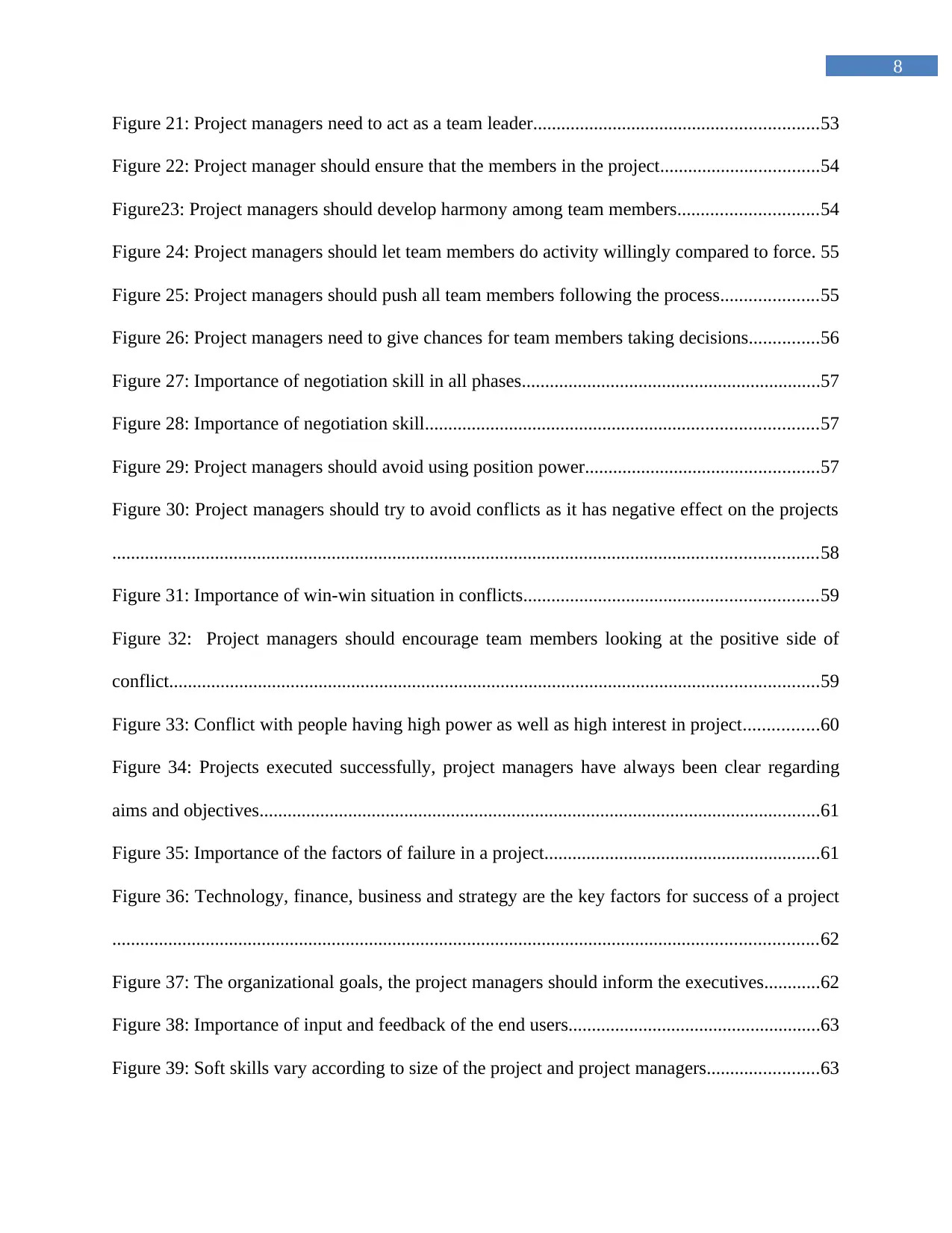
8
Figure 21: Project managers need to act as a team leader.............................................................53
Figure 22: Project manager should ensure that the members in the project..................................54
Figure23: Project managers should develop harmony among team members..............................54
Figure 24: Project managers should let team members do activity willingly compared to force. 55
Figure 25: Project managers should push all team members following the process.....................55
Figure 26: Project managers need to give chances for team members taking decisions...............56
Figure 27: Importance of negotiation skill in all phases................................................................57
Figure 28: Importance of negotiation skill....................................................................................57
Figure 29: Project managers should avoid using position power..................................................57
Figure 30: Project managers should try to avoid conflicts as it has negative effect on the projects
.......................................................................................................................................................58
Figure 31: Importance of win-win situation in conflicts...............................................................59
Figure 32: Project managers should encourage team members looking at the positive side of
conflict...........................................................................................................................................59
Figure 33: Conflict with people having high power as well as high interest in project................60
Figure 34: Projects executed successfully, project managers have always been clear regarding
aims and objectives........................................................................................................................61
Figure 35: Importance of the factors of failure in a project...........................................................61
Figure 36: Technology, finance, business and strategy are the key factors for success of a project
.......................................................................................................................................................62
Figure 37: The organizational goals, the project managers should inform the executives............62
Figure 38: Importance of input and feedback of the end users......................................................63
Figure 39: Soft skills vary according to size of the project and project managers........................63
Figure 21: Project managers need to act as a team leader.............................................................53
Figure 22: Project manager should ensure that the members in the project..................................54
Figure23: Project managers should develop harmony among team members..............................54
Figure 24: Project managers should let team members do activity willingly compared to force. 55
Figure 25: Project managers should push all team members following the process.....................55
Figure 26: Project managers need to give chances for team members taking decisions...............56
Figure 27: Importance of negotiation skill in all phases................................................................57
Figure 28: Importance of negotiation skill....................................................................................57
Figure 29: Project managers should avoid using position power..................................................57
Figure 30: Project managers should try to avoid conflicts as it has negative effect on the projects
.......................................................................................................................................................58
Figure 31: Importance of win-win situation in conflicts...............................................................59
Figure 32: Project managers should encourage team members looking at the positive side of
conflict...........................................................................................................................................59
Figure 33: Conflict with people having high power as well as high interest in project................60
Figure 34: Projects executed successfully, project managers have always been clear regarding
aims and objectives........................................................................................................................61
Figure 35: Importance of the factors of failure in a project...........................................................61
Figure 36: Technology, finance, business and strategy are the key factors for success of a project
.......................................................................................................................................................62
Figure 37: The organizational goals, the project managers should inform the executives............62
Figure 38: Importance of input and feedback of the end users......................................................63
Figure 39: Soft skills vary according to size of the project and project managers........................63
⊘ This is a preview!⊘
Do you want full access?
Subscribe today to unlock all pages.

Trusted by 1+ million students worldwide
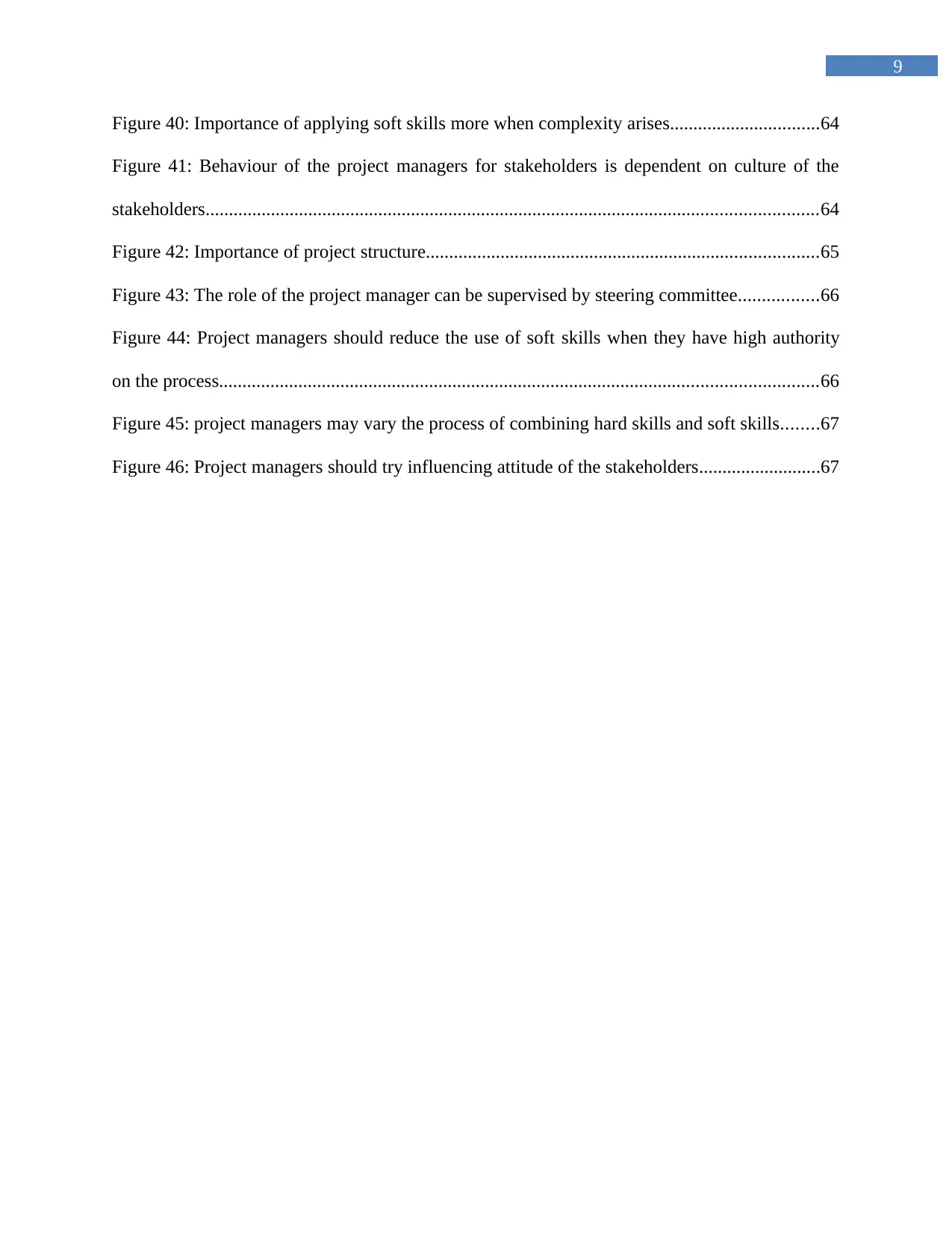
9
Figure 40: Importance of applying soft skills more when complexity arises................................64
Figure 41: Behaviour of the project managers for stakeholders is dependent on culture of the
stakeholders...................................................................................................................................64
Figure 42: Importance of project structure....................................................................................65
Figure 43: The role of the project manager can be supervised by steering committee.................66
Figure 44: Project managers should reduce the use of soft skills when they have high authority
on the process................................................................................................................................66
Figure 45: project managers may vary the process of combining hard skills and soft skills........67
Figure 46: Project managers should try influencing attitude of the stakeholders..........................67
Figure 40: Importance of applying soft skills more when complexity arises................................64
Figure 41: Behaviour of the project managers for stakeholders is dependent on culture of the
stakeholders...................................................................................................................................64
Figure 42: Importance of project structure....................................................................................65
Figure 43: The role of the project manager can be supervised by steering committee.................66
Figure 44: Project managers should reduce the use of soft skills when they have high authority
on the process................................................................................................................................66
Figure 45: project managers may vary the process of combining hard skills and soft skills........67
Figure 46: Project managers should try influencing attitude of the stakeholders..........................67
Paraphrase This Document
Need a fresh take? Get an instant paraphrase of this document with our AI Paraphraser
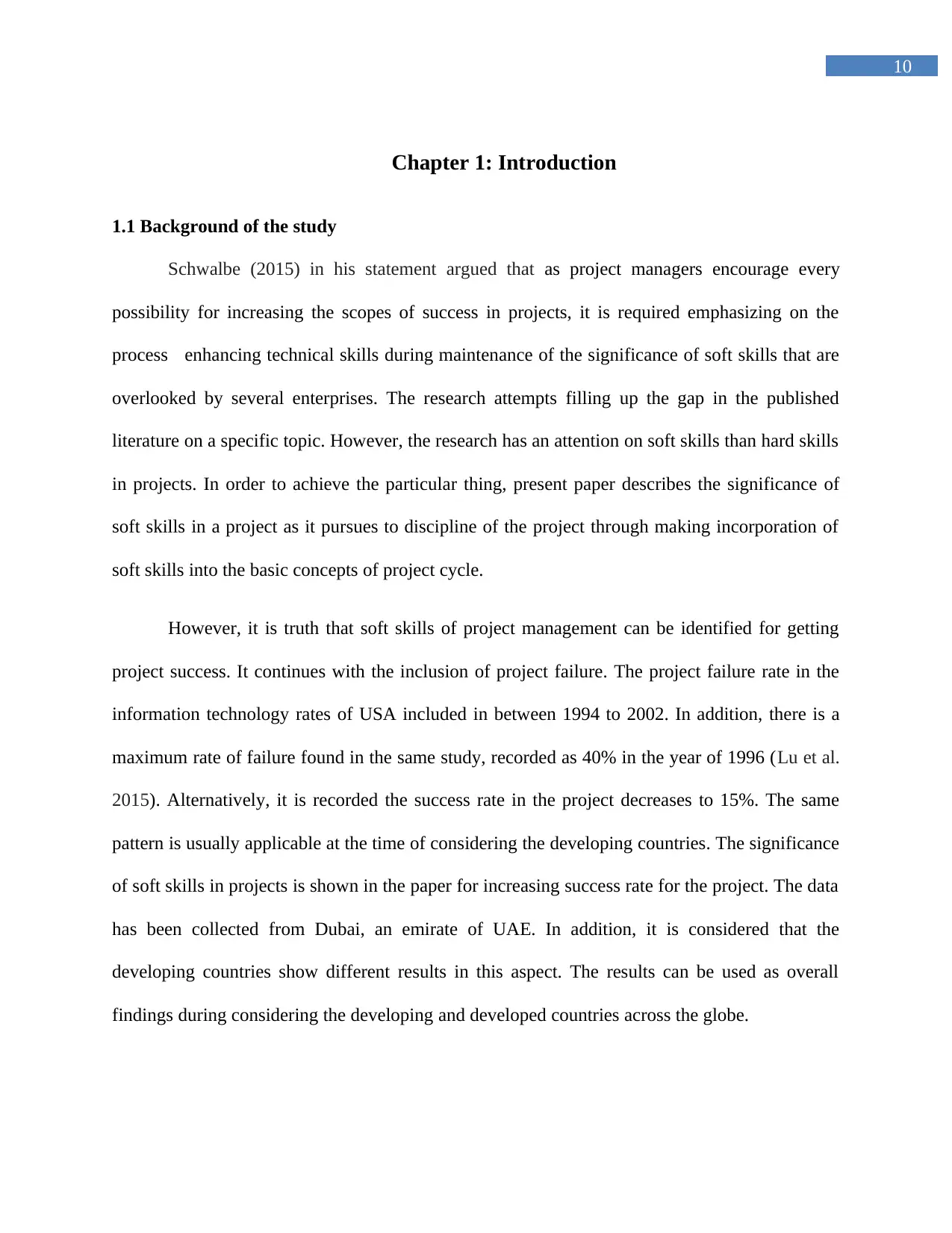
10
Chapter 1: Introduction
1.1 Background of the study
Schwalbe (2015) in his statement argued that as project managers encourage every
possibility for increasing the scopes of success in projects, it is required emphasizing on the
process enhancing technical skills during maintenance of the significance of soft skills that are
overlooked by several enterprises. The research attempts filling up the gap in the published
literature on a specific topic. However, the research has an attention on soft skills than hard skills
in projects. In order to achieve the particular thing, present paper describes the significance of
soft skills in a project as it pursues to discipline of the project through making incorporation of
soft skills into the basic concepts of project cycle.
However, it is truth that soft skills of project management can be identified for getting
project success. It continues with the inclusion of project failure. The project failure rate in the
information technology rates of USA included in between 1994 to 2002. In addition, there is a
maximum rate of failure found in the same study, recorded as 40% in the year of 1996 (Lu et al.
2015). Alternatively, it is recorded the success rate in the project decreases to 15%. The same
pattern is usually applicable at the time of considering the developing countries. The significance
of soft skills in projects is shown in the paper for increasing success rate for the project. The data
has been collected from Dubai, an emirate of UAE. In addition, it is considered that the
developing countries show different results in this aspect. The results can be used as overall
findings during considering the developing and developed countries across the globe.
Chapter 1: Introduction
1.1 Background of the study
Schwalbe (2015) in his statement argued that as project managers encourage every
possibility for increasing the scopes of success in projects, it is required emphasizing on the
process enhancing technical skills during maintenance of the significance of soft skills that are
overlooked by several enterprises. The research attempts filling up the gap in the published
literature on a specific topic. However, the research has an attention on soft skills than hard skills
in projects. In order to achieve the particular thing, present paper describes the significance of
soft skills in a project as it pursues to discipline of the project through making incorporation of
soft skills into the basic concepts of project cycle.
However, it is truth that soft skills of project management can be identified for getting
project success. It continues with the inclusion of project failure. The project failure rate in the
information technology rates of USA included in between 1994 to 2002. In addition, there is a
maximum rate of failure found in the same study, recorded as 40% in the year of 1996 (Lu et al.
2015). Alternatively, it is recorded the success rate in the project decreases to 15%. The same
pattern is usually applicable at the time of considering the developing countries. The significance
of soft skills in projects is shown in the paper for increasing success rate for the project. The data
has been collected from Dubai, an emirate of UAE. In addition, it is considered that the
developing countries show different results in this aspect. The results can be used as overall
findings during considering the developing and developed countries across the globe.
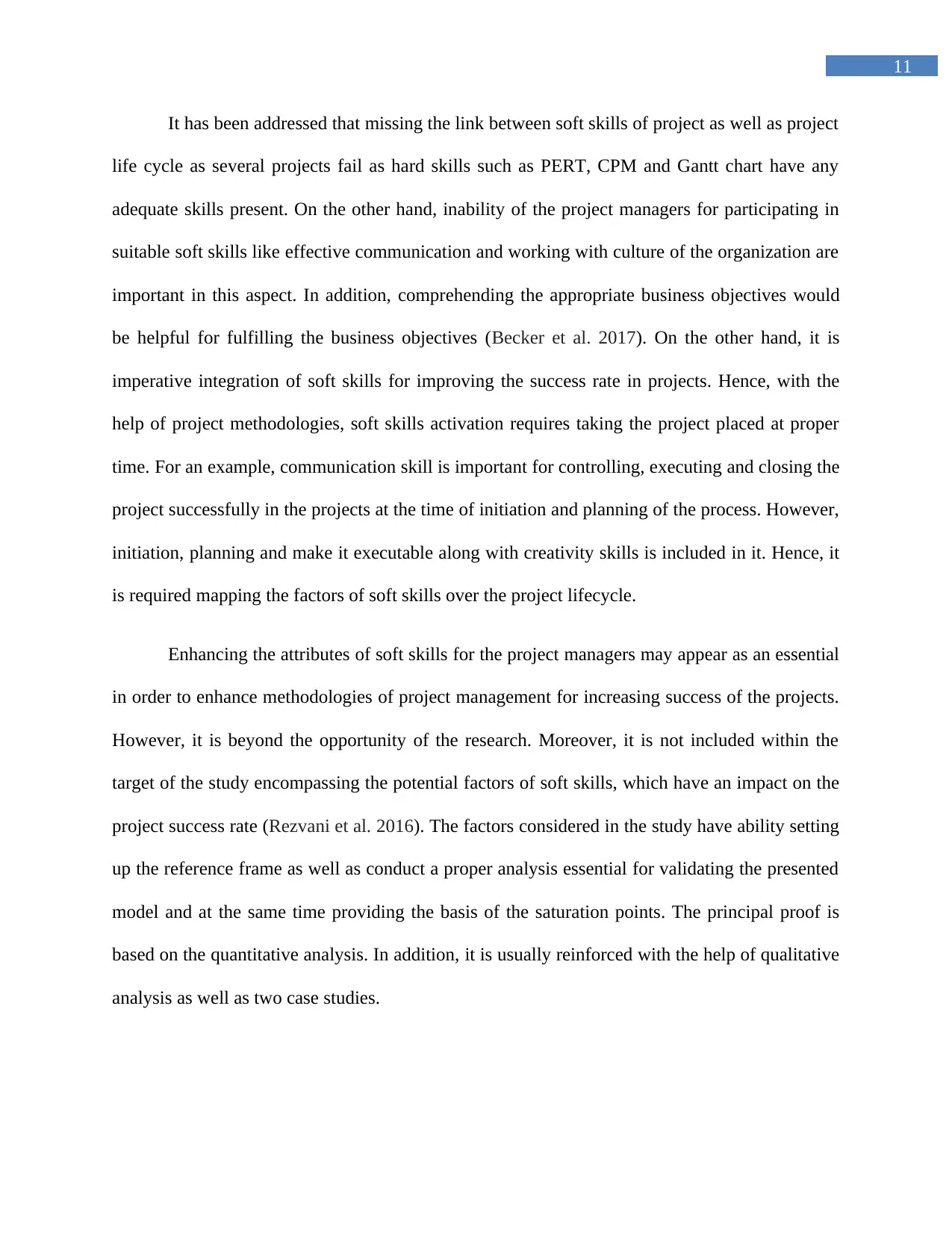
11
It has been addressed that missing the link between soft skills of project as well as project
life cycle as several projects fail as hard skills such as PERT, CPM and Gantt chart have any
adequate skills present. On the other hand, inability of the project managers for participating in
suitable soft skills like effective communication and working with culture of the organization are
important in this aspect. In addition, comprehending the appropriate business objectives would
be helpful for fulfilling the business objectives (Becker et al. 2017). On the other hand, it is
imperative integration of soft skills for improving the success rate in projects. Hence, with the
help of project methodologies, soft skills activation requires taking the project placed at proper
time. For an example, communication skill is important for controlling, executing and closing the
project successfully in the projects at the time of initiation and planning of the process. However,
initiation, planning and make it executable along with creativity skills is included in it. Hence, it
is required mapping the factors of soft skills over the project lifecycle.
Enhancing the attributes of soft skills for the project managers may appear as an essential
in order to enhance methodologies of project management for increasing success of the projects.
However, it is beyond the opportunity of the research. Moreover, it is not included within the
target of the study encompassing the potential factors of soft skills, which have an impact on the
project success rate (Rezvani et al. 2016). The factors considered in the study have ability setting
up the reference frame as well as conduct a proper analysis essential for validating the presented
model and at the same time providing the basis of the saturation points. The principal proof is
based on the quantitative analysis. In addition, it is usually reinforced with the help of qualitative
analysis as well as two case studies.
It has been addressed that missing the link between soft skills of project as well as project
life cycle as several projects fail as hard skills such as PERT, CPM and Gantt chart have any
adequate skills present. On the other hand, inability of the project managers for participating in
suitable soft skills like effective communication and working with culture of the organization are
important in this aspect. In addition, comprehending the appropriate business objectives would
be helpful for fulfilling the business objectives (Becker et al. 2017). On the other hand, it is
imperative integration of soft skills for improving the success rate in projects. Hence, with the
help of project methodologies, soft skills activation requires taking the project placed at proper
time. For an example, communication skill is important for controlling, executing and closing the
project successfully in the projects at the time of initiation and planning of the process. However,
initiation, planning and make it executable along with creativity skills is included in it. Hence, it
is required mapping the factors of soft skills over the project lifecycle.
Enhancing the attributes of soft skills for the project managers may appear as an essential
in order to enhance methodologies of project management for increasing success of the projects.
However, it is beyond the opportunity of the research. Moreover, it is not included within the
target of the study encompassing the potential factors of soft skills, which have an impact on the
project success rate (Rezvani et al. 2016). The factors considered in the study have ability setting
up the reference frame as well as conduct a proper analysis essential for validating the presented
model and at the same time providing the basis of the saturation points. The principal proof is
based on the quantitative analysis. In addition, it is usually reinforced with the help of qualitative
analysis as well as two case studies.
⊘ This is a preview!⊘
Do you want full access?
Subscribe today to unlock all pages.

Trusted by 1+ million students worldwide
1 out of 130
Related Documents
Your All-in-One AI-Powered Toolkit for Academic Success.
+13062052269
info@desklib.com
Available 24*7 on WhatsApp / Email
![[object Object]](/_next/static/media/star-bottom.7253800d.svg)
Unlock your academic potential
Copyright © 2020–2025 A2Z Services. All Rights Reserved. Developed and managed by ZUCOL.





